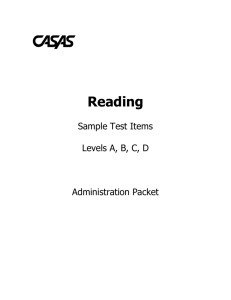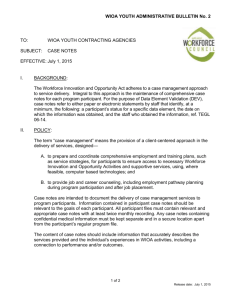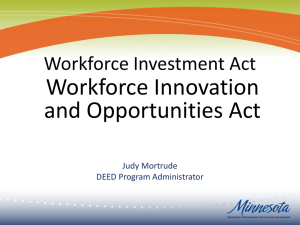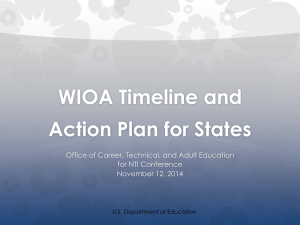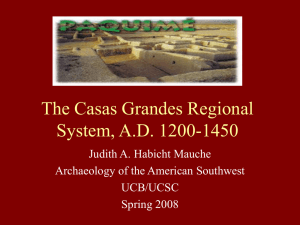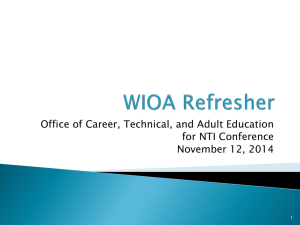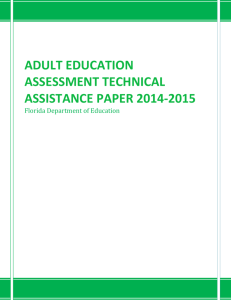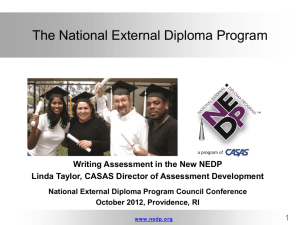2015 June 23-25 - Nevada Adult Education Nevada Adult Education
advertisement
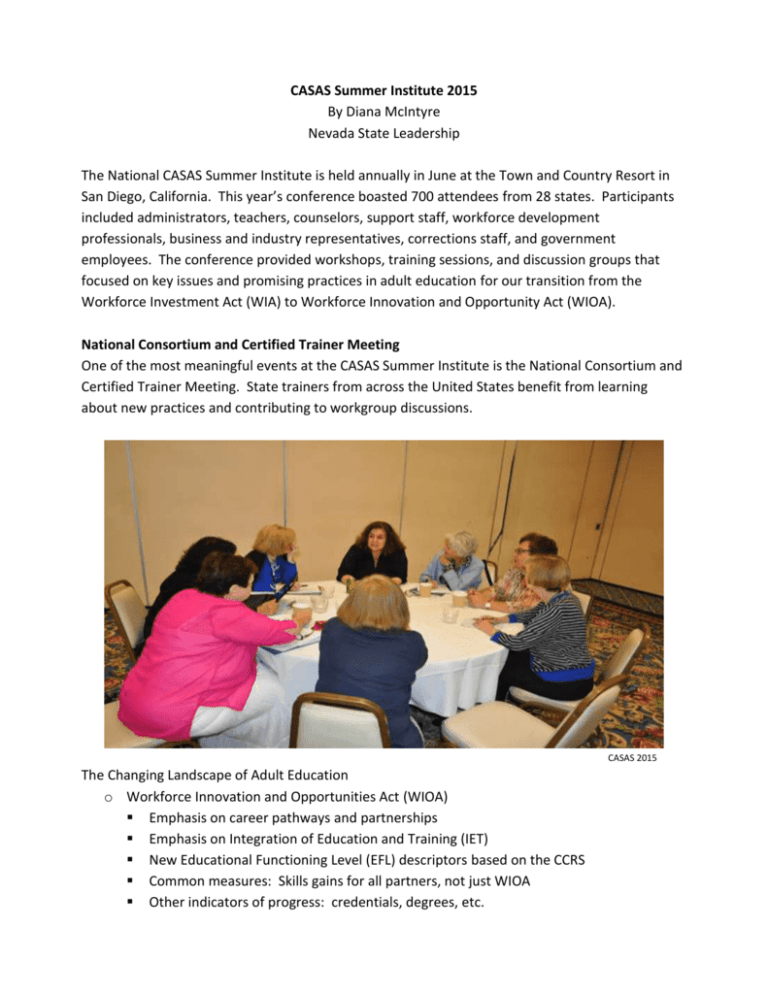
CASAS Summer Institute 2015 By Diana McIntyre Nevada State Leadership The National CASAS Summer Institute is held annually in June at the Town and Country Resort in San Diego, California. This year’s conference boasted 700 attendees from 28 states. Participants included administrators, teachers, counselors, support staff, workforce development professionals, business and industry representatives, corrections staff, and government employees. The conference provided workshops, training sessions, and discussion groups that focused on key issues and promising practices in adult education for our transition from the Workforce Investment Act (WIA) to Workforce Innovation and Opportunity Act (WIOA). National Consortium and Certified Trainer Meeting One of the most meaningful events at the CASAS Summer Institute is the National Consortium and Certified Trainer Meeting. State trainers from across the United States benefit from learning about new practices and contributing to workgroup discussions. CASAS 2015 The Changing Landscape of Adult Education o Workforce Innovation and Opportunities Act (WIOA) Emphasis on career pathways and partnerships Emphasis on Integration of Education and Training (IET) New Educational Functioning Level (EFL) descriptors based on the CCRS Common measures: Skills gains for all partners, not just WIOA Other indicators of progress: credentials, degrees, etc. Preparing Adult Learners for the 21st Century o CASAS strategies to support states and address WIOA implementation Assessment-Alignment with new National Reporting System (NRS) Level Descriptors Transitions-Document skills gains and workforce skills Technology-Interoperability with WIOA partners Integrated Partnership Model The Title II funded ABE agency takes responsibility for the intake process, education, assessments, and student skills gain. One Stop Business Partner takes responsibility for job training and placement. Out of school youth, ages 16-24, who are skill deficient, are the target group. The WIOA is now looking to spend 75% of their Title 1 primary funds on this target group. Renewed commitment to workforce development. I elected to participate in the Integrated Partnership Model discussion group because I know our state would benefit from this achievable enterprise. While our Adult Education and Family Literacy Act (AEFLA) funded programs continue to educate, assess, and track student skills gains, we could easily work jointly with a One Stop Business Partner who helps to provide job training and placement. One Stops provide access to training services throughout Nevada and supplementary access to technology. Adult Basic Education (ABE) and English as a Second Language (ESL) students with barriers to economic success, who are basic skill deficient, lowincome, etc. would greatly benefit from career services delivered from a One Stop Partner. Pat Ricard, CASAS President, emphasized that WIOA is now required to spend 75% of their budget on out-of-school youth, and that the target age group increased from 21 to 24. Another important component of WIOA is Career Pathways which are greatly encouraged for both youth and adult students. A broader focus now exists on Adult Education and the transition to the labor market. Career Pathways calls for increasing skills, competencies, and credentials informed by industry and employers that allows for multiple entry paths. Nevada AEFLA funded programs can provide the desired rigorous and high-quality education, training and services aligned with local business needs of industries to help support our state economy through community partnerships. This discussion group caused me to research further possibilities and contact a local One Stop Partner to determine how we can leverage each other’s strengths. National External Diploma Program (NEDP) Offers an alternate pathway to high school completion. Reflects real performance tasks. Develops and assesses technology skills through the online, self-paced program. Allows eligible participants to earn a high school diploma while employed, enrolled in job training, or managing other commitments. NEDP builds on CASAS assessments including the Reading, Math and Written Prompt. CASAS National Consortium ESL Committee Meeting Meeting facilitator and CASAS Director of Assessment and Development, Linda Taylor, provided an update on the CASAS assessment series being developed. New Assessment Series The clock is ticking; Adult Basic Education (ABE) programs anxiously anticipate the National Reporting System (NRS) approval followed by the Comprehensive Adult Student Assessment System (CASAS) release of the new assessment reading series aligned with the College and Career Readiness Standards (CCRS) for Adult Education. An English as a Second Language (ESL) version will follow. Timeline 2014-2015 – Write and field-test new items 2015-2016 – Conduct research studies with new test forms 2016-2017 – Submit series to NRS for approval 2017 - Ready for programs to use o Test content will be aligned with College and Career Readiness Standards (CCRS) for Adult Education Reading Test-Comprehension questions will draw on higher order reading skills, including citing evidence from complex tests. Math Test-Math concepts will be assessed via common life and work applications. All NRS levels will be covered in the four test levels (A, B, C, D) Both paper and computer based administration will be available. Presentations There were numerous presentations to choose from. Topics included how agencies were implementing the CCRS, implications of WIOA, teaching vocabulary, citizenship, common core, transition programs, CASAS assessment trainings, eTests, and technology. Key Note Speaker Virginia Hamilton serves as the Regional Administrator for the Employment and Training Administration at the U.S. Department of Labor in 8 Western states, including Nevada, Hawaii and Alaska, and 4 territories in the Pacific. Her office oversees the Workforce Investment Act, Job Service, Unemployment Insurance, Trade Act, and discretionary grants such as the Trade Adjustment Assistance Community College and Career Training Grant Program (TAACCCT), Youth Build, Ex-Offender, and National Emergency Grants. Virginia spoke about the importance of the emotional state of mind and experience of customers of One Stop Career Shops. Are One Stop’s welcoming, and are they meeting the needs of the diverse clientele? There is a difference between the person who gets no response from a resume and a person who doesn’t know what skills they need or how to begin. Some people really only need a job; servicing sub groups. Examine the One Stop’s relationship with the local business community. The types of skill training provided and procedures in place at One Stop’s can greatly change a customer’s experience for the better. New WIOA law dictates, at the end of the day, everyone should have a job and be able to sustain themselves and their family. An interesting presentation by the U.S. Department of Homeland Security, DC, involved Exploring Brain-Based Learning for the Citizenship Classroom and Creating and Adapting Effective Learning Activities. The presenters talked about different parts of the brain and focused on reasons for and ways to scaffold instruction. Scaffolding is like a building, supports workers on a specific task, is temporary, is gradually removed, and shifts. Not everything should be scaffolded. Ways to scaffold entail using advanced organizers, concept and mind maps, cue cards, question stems, providing hints, providing anticipation guides, handouts, and hands-on activities CCRS College and Career Readiness Standards (CCRS) for Adult Education I had the opportunity to present a CASAS Beyond Implementation Training at the Summer Institute. Not only was I able to share many of Nevada’s best practices, but it was interesting hearing about different in-take processes at programs across the U.S. Conference Location The conference property, located in the heart of San Diego, may be one of San Diego’s the best kept secrets. Framed in palm trees and nestled next to the River Walk Golf Course, it is nearly impossible to walk the grounds without stopping to smell some of the thousands of roses that flourish in the pleasant Southern California climate. The resort boasts three pools and is walking distance from the Fashion Valley Mall and the Trolley that conveniently transports you throughout San Diego. Nearby tourist destinations include miles of beaches, Seaport Village, Old Town, Balboa Park, San Diego Zoo, Sea World, and the Gaslamp Quarter. Resources CASAS Presentations/Slides and Handouts www.casas.org/training-and-support/SI/presentations WIOA www2.ed.gov/AEFLA http://www.clasp.org/resources-and-publications/publication-1/KeyProvisionsofWIOA-Final.pdf NRS Test Benchmarks for Educational Functioning Levels (EFL) http://www.nrsweb.org/foundations/related_documents.aspx

